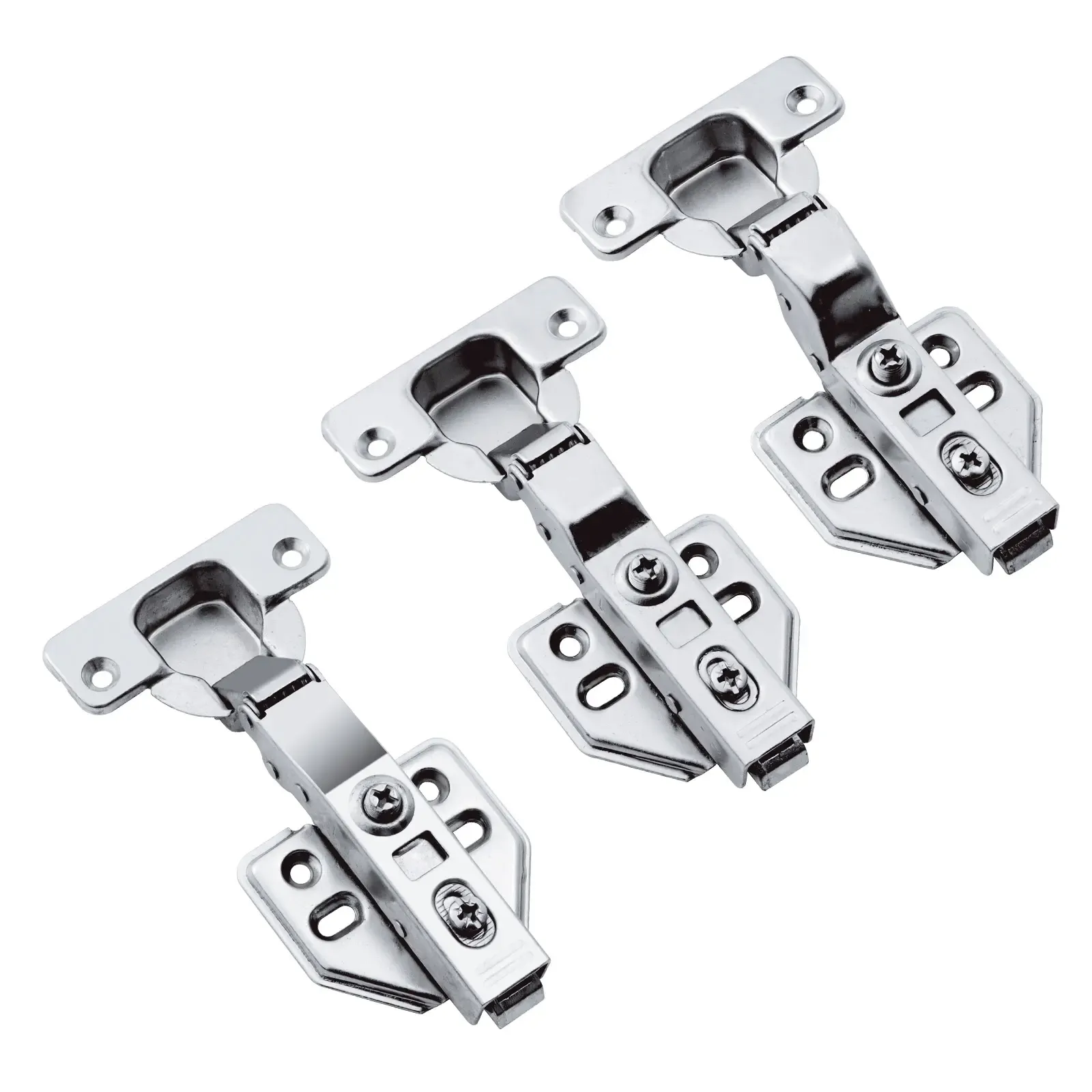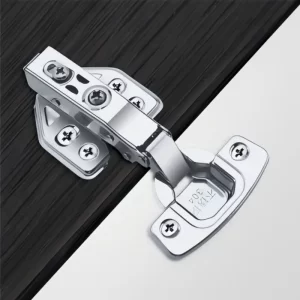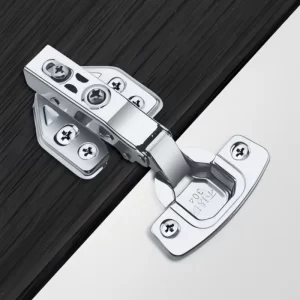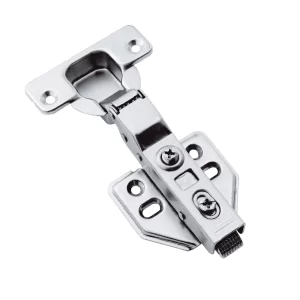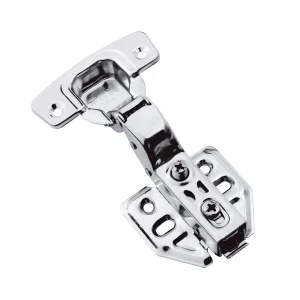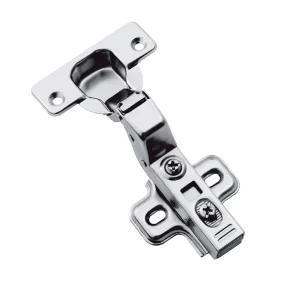Hinge angle is a small decision with big consequences. The angle of a hinge determines how much access you get inside the cabinet, how the cabinet door interacts with nearby walls or appliances, and even what hardware you must use.
In this article, Mingrun, a professional hinge manufacturer, explains what a hinge angle is, how cabinet opening angle differs in practice, and when to pick 90°, 110°, or 165° hinges for common applications.
What is Hinge Angle
A hinge angle is the maximum angle (in degrees) a door can open, measured from the closed position. It directly defines the cabinet opening angle — the clear space between the door and the cabinet when fully opened. The nominal angle (e.g., 90°, 110°, 165°) is a manufacturer spec, but the effective opening you get can be less because of door thickness, handle projection, overlay/inset configuration, or stops.
Why it matters:
- Access: Wider angles give easier access to deep cabinets and appliance openings.
- Clearance: Narrow angles avoid collisions in tight spaces.
- Aesthetics & function: Some designs require doors to sit flush at full open or fold flat for servicing.

Quick Summary: 90°, 110°, 165° At A Glance
90° (Short-open)
- Use: Shallow overhead cabinets, tight corridors, or where a door must not swing beyond a profile.
- Pros: Minimizes interference with adjacent furniture or walls.
- Cons: Limited access; not suitable for deep shelves or appliances.
110° (Medium-open / Most common)
- Use: Standard kitchen base and wall cabinets.
- Pros: Good balance between clearance and access; works with most concealed European hinges.
- Cons: May still restrict full access in very deep cabinets or corner applications.
165° (Wide-open / Full access)
- Use: Corner cabinets, appliance doors, service panels, and areas where a near-flat opening is desirable.
- Pros: Maximizes internal access and makes loading/unloading easy.
- Cons: Requires more side clearance and can exert larger lever forces at the mounting plate.

How Hinge Design Creates Different Opening Angles
Hinge geometry — arm length, cup position, mounting plate offset, and built-in cam or stop — determines the hinge angle. Concealed (European) hinges commonly come in defined angle variants; their cup depth and arm profile set how the door swings relative to the cabinet face.
Key Points:
- The shape and length of the hinge arm, as well as the depth of its cup position, collectively determine the opening angle of a cabinet hinge. This is the essential factor for the maximum angle of hinge opening.
- A cam or stop/detect structure integrated inside the hinge precisely limits the opening angle to a specific value.
- Even for the same type of hinge, the offset of the mounting plate and the overlay or inset configuration of the door panel will change the actual swing trajectory of the door panel relative to the cabinet side panel, thereby affecting the final effective access angle.
Cabinet Factors that Reduce Effective Opening
Several real-world factors reduce the practical cabinet opening angle below the hinge’s nominal rating:
- Door thickness and handle projection — thick doors or protruding handles hit adjacent surfaces sooner.
- Face-frame vs. frameless construction — face frames can obstruct the opening if not accounted for.
- Adjacent doors, walls, or appliances — cooktops, refrigerators, and neighboring doors often limit safe swing.
- Backstops, valances, or filler panels — architectural elements can block a full opening.
Always test with a mock-up or a sample hinge and door before finalizing the design.
Installation and Practical Considerations
When selecting a hinge angle, follow these practical steps:
- Measure clearance — sketch the door swing arc and check for collisions with walls, appliances, and adjacent doors.
- Decide access needs — do you require full internal access (choose larger angles) or must you limit swing for clearance (choose smaller angles)?
- Confirm hinge load rating — wide-angle hinges often produce greater leverage on the door and mounting plate; use reinforced plates or additional hinges for tall/heavy doors.
- Account for handles — measure handle projection and include it in the swing envelope.
- Test-fit — trial a sample door/hinge assembly to confirm the effective cabinet opening angle in situ.
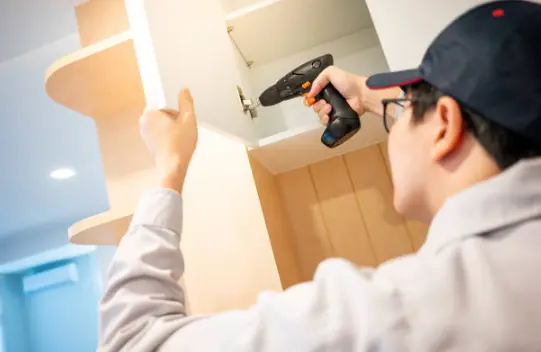
Quick Reference: Which Angle to Choose
- 90°: Compact upper cabinets, tight corridors, and inset shallow doors.
- 110°: Standard kitchen cabinets, best all-around choice for general cabinetry.
- 165°: Corner units, appliance/service doors, full-access requirements.
FAQ
Q: Door hits wall at ~45° — what should I check?
A: Check handle projection and face-frame interference; use a shallower cup, smaller hinge angle, or add an offset plate to increase clearance.
Q: Door won’t open to the hinge’s rated angle — what causes this?
A: Verify mounting-plate offset and cup depth, and confirm no internal obstructions (valance, filler, adjacent doors); adjust plate or select a wider-angle hinge.
Q: Hinge loosens over time on wide-angle doors — how to prevent?
A: Use heavier-duty hinges, longer screws, reinforced mounting plates or backing blocks, and add extra hinge points for tall/heavy doors.
Q: My cabinet door slams or bangs — what can I do quickly?
A: Fit a soft-close hinge or adjust the existing hinge stop/damping; a simple damped hinge upgrade stops slamming immediately.
Q: My cabinet door rubs or is hard to open — any quick fix?
A: Check for visible obstructions and tighten screws; if rubbing persists, adjust the hinge depth/side screws or call a fitter to re-set the cup.
About Mingrun

At Mingrun, precision meets reliability. As a professional hinge manufacturer, we specialize in wholesaling hinges for cabinets and furniture. With our own factory and advanced production lines, we deliver bulk cabinet hinge orders with consistent quality in our custom hinge solutions. Every product undergoes a rigorous QA process that meets international standards, ensuring durability and smooth performance for every installation.

